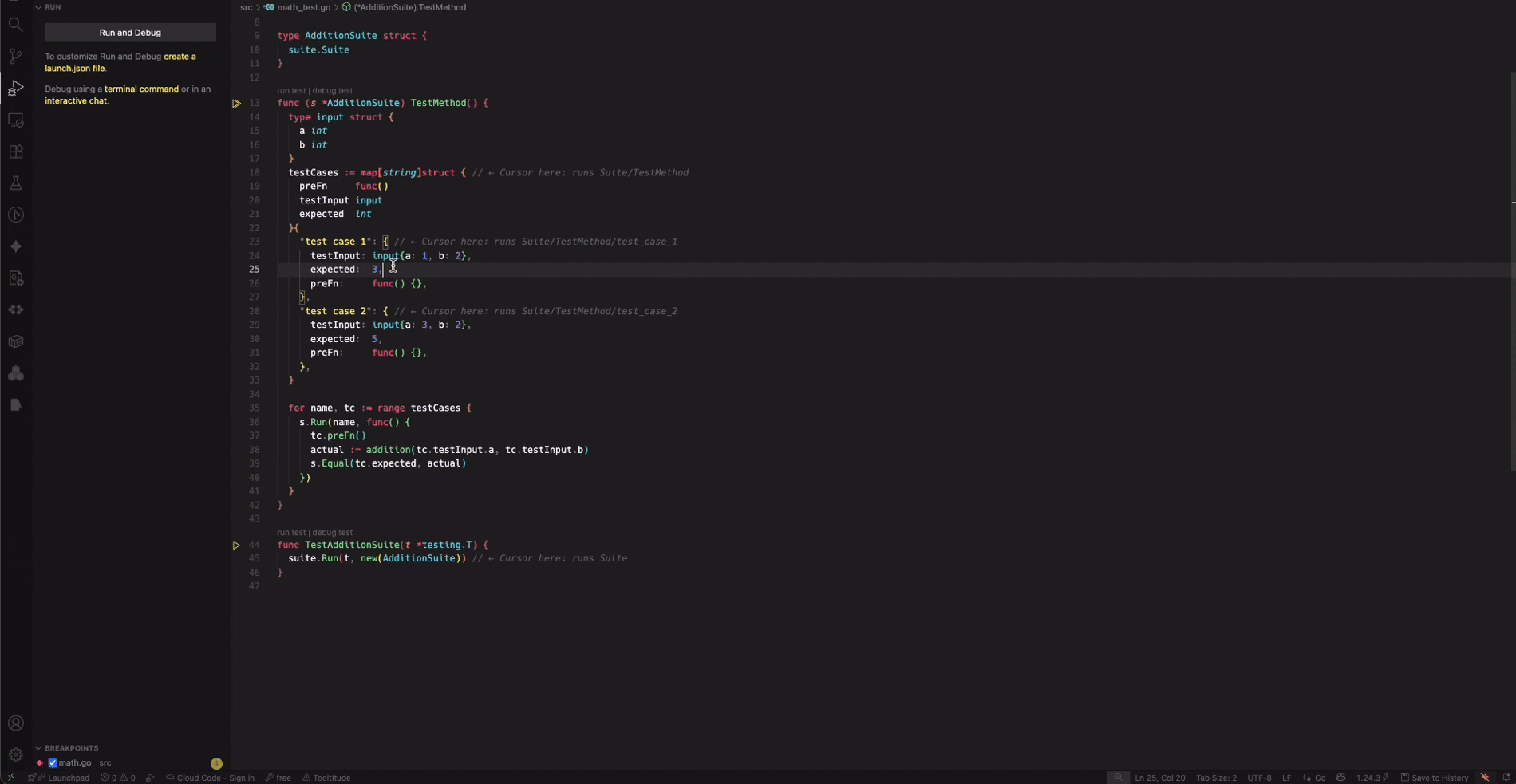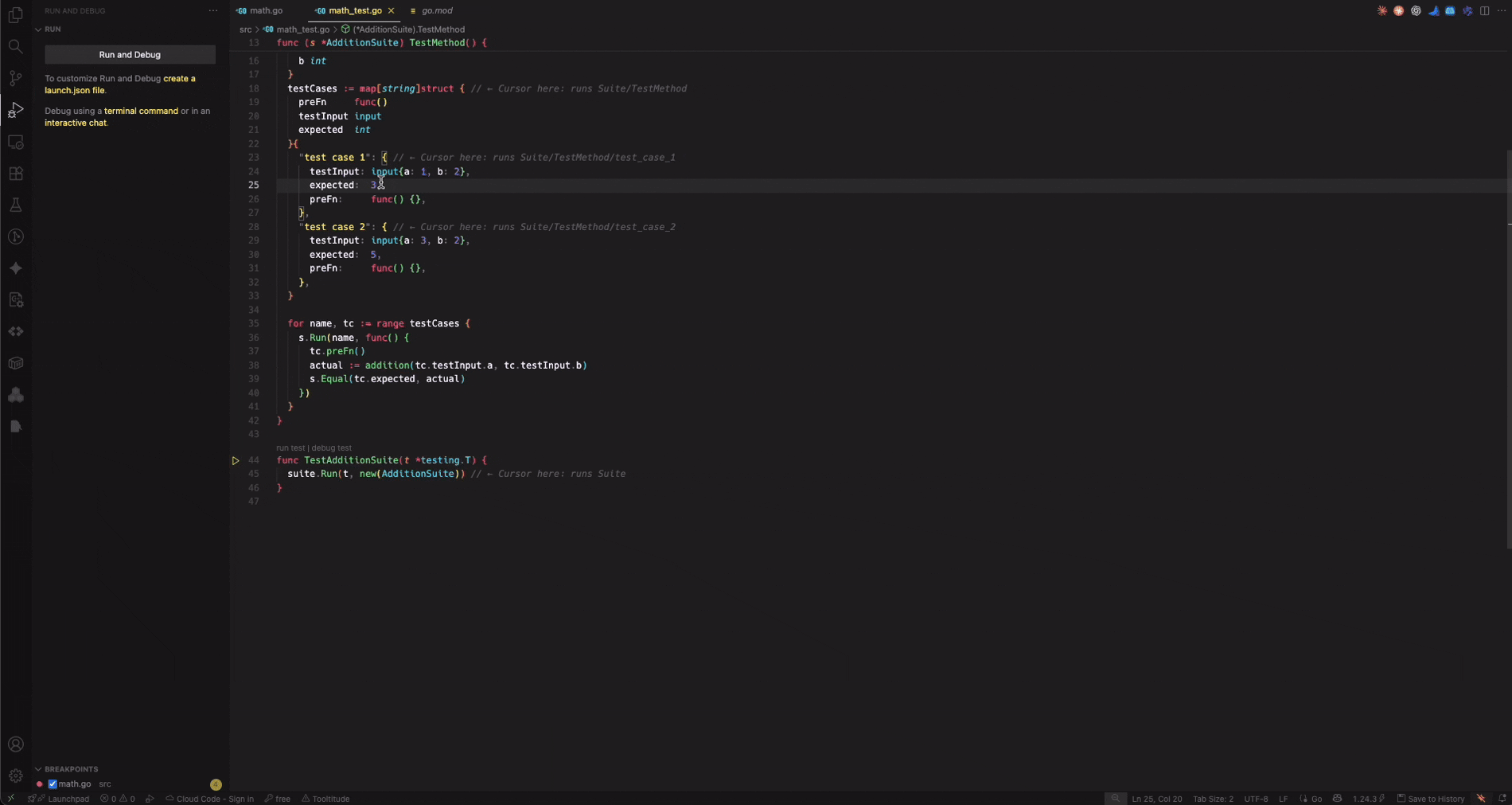Go Table Driven Design Test Runner
This VSCode extension enables the following key bindings to run and debug Go table-driven design tests.
| Execution |
Keybinding |
Description |
| Run test |
cmd+j |
Run the test that I'm looking at (context-aware). Great for targeting a single test. |
| Run test function |
cmd+u |
Run all the tests within the test function |
| Run test debugger |
cmd+shift+j |
Works similar to Run test. Except, it runs with the debugger |
Run Test
The extension executes the test with go test

Run Test Debugger
The extension launches a debugger processor and hooks up with the VSCode IDE.

Features
This extension runs table-driven design tests that are most compatible with the conventions stated in the testify documentation and Dave Chaney's table-driven design conventions:
- Using a Map to Store Test Cases
testCases := map[string]struct {
preFn func()
testInput input
expected int
}{
"test case 1": {
testInput: input{a: 1, b: 2},
expected: 3,
preFn: func() {},
},
"test case 2": {
testInput: input{a: 3, b: 2},
expected: 5,
preFn: func() {},
},
}
for name, tc := range testCases {
s.Run(name, func() {
tc.preFn()
actual := addition(tc.testInput.a, tc.testInput.b)
s.Equal(tc.expected, actual)
})
}
- Using a Slice with
name to Store Test Cases
testCases := []struct {
name string
preFn func()
testInput input
expected int
}{
{
name: "test case 1",
testInput: input{a: 1, b: 2},
expected: 3,
preFn: func() {},
},
{
name: "test case 2",
testInput: input{a: 3, b: 2},
expected: 5,
preFn: func() {},
},
}
for _, tc := range testCases {
s.Run(tc.name, func() {
tc.preFn()
actual := addition(tc.testInput.a, tc.testInput.b)
s.Equal(tc.expected, actual)
})
}
How does it work?
Based on where your cursor is, the test runner will execute the test method accordingly
func (s *Suite) TestMethod() {
testCases := map[string]struct{ // ← cmd+j Cursor here: runs Suite/TestMethod/
// ...
}{
"test case 1": { // ← cmd+j Cursor here: runs Suite/TestMethod/test_case_1
field: "value", // ← cmd+u Cursor here: runs Suite/TestMethod/
},
}
for name, tc := range testCases {
s.Run(name, func() {
tc.preFn()
})
}
}
func TestSuite(t *testing.T) {
suite.Run(t, new(Suite)) // ← cmd+j Cursor here: runs Suite
}
Requirements
Keybindings
You can edit the keybindings by pasting this in Code -> Preferences > Keyboard Shortcuts -> keybindings.json
{
"command": "goTDDRunner.runTest",
"key": "cmd+m",
"when": "editorLangId == go"
},
{
"command": "goTDDRunner.debugTest",
"key": "cmd+shift+m",
"when": "editorTextFocus && editorLangId == 'go'"
},
{
"command": "goTDDRunner.runTestFunction",
"key": "cmd+b",
"when": "editorLangId == 'go'"
}
Contributions
This project is still in its early stages so contributions are welcome 🤗
Feel free to create an issue if you have any feature requests ✍️ or bugs to report 🐛. If you're up for it you can open a PR to make a contribution!



